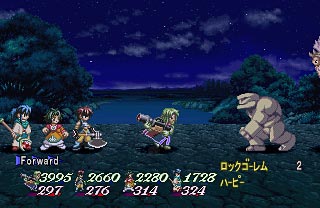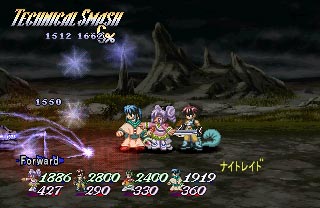 |
Tales of Destiny II - Retroview
|  |
A small step forward for the Tales
By: Phillipe Richer
| Review Breakdown | | Battle System |
9
| | Interface |
8
| | Music & Sound |
6
| | Originality |
6
| | Story & Plot |
5
| | Localization |
8
| | Replay Value |
5
| | Visuals |
8
| | Difficulty |
Moderate or Hard
| | Completion Time |
35-45 Hours
| | | Overall |

|
 | |
Be careful where you aim that thing! |
|
Tales of Destiny II arrived to North America in the fall of 2001. Although the game is titled Tales of Eternia in Japan, Namco decided to pull a marketing stunt on us by changing the game's appellation, meaning that they will have to be really clever once the real Tales of Destiny II is released stateside. Inane ramblings aside, ToD II continues with the phenomenal gameplay the series has become known for and is unfortunately also driven by an unmotivated and dragged-on plot; just like its brethrens were.
Reid and Farah have been friends forever, living peacefully in their quiet village of Rasheans. The residents of their planet, Inferia, have always been in the dark concerning the purpose and realities of Celestia, the world located in another dimension and distinguishable far above to the naked eye. The two worlds are known as a single entity, Eternia. On a fateful day, a spacecraft piloted by a strange girl falls in the forest of Rasheans. Reid and Farah rush to meet the mysterious girl who appears to be carrying the message of a nearing catastrophe. Even without knowing many details concerning this new threat, Reid, Farah, and this mysterious girl all set-out on their journey to protect all of Eternia. Too bad the plot twists will only occur once in a decade along their quest.
Once again, the Enhanced Linear Motion Battle (E-LMB) is part of a Tales game. Battles are fought on a single plane where all combatants are dropped to raise havoc. Unlike the previous game, the player can know choose to control any party member he desires. Normal attacks can now be linked together for more devastating results, something which will also net you more exp. depending on the length and quality of your combos. You can set up to four special attacks to be used in battle by pressing the d-pad and the special skills button. It is possible to set two spells from any of your allies to the L2 and R2 shoulders button for instant on-demand firepower. Also, guarding has become much more helpful than in ToD, so no more are battles simply a matter of incessant offensive strikes. Again, for your allies to cast spells and initiate their potent special skills, you must first open the in-battle menu to select the desired command.
Comparatively to the first game, the battles have become much more complex in every respect, though some additions will probably remain unknown to you given their lack of usefulness. In addition to being able to reverse your formation and assign targets to your allies, it is now possible to quickly gather your troop and even make them jump simultaneously for airborne attacks (why everybody at once?). The A.I. options are now much more varied, while the opportunity to have four gamers playing at once will surely please many people. With all those novelties, battling monsters in ToD II is a joy. This entire real-time setup allows players to really hone their skills over time and to get more involved with the mundane random combats. For the gameplay to be absolutely perfect, I would've proposed fewer yet longer battles. Dungeons sometimes get a little tedious given the relatively high encounter rate, though the early availability of battle-evading items renders this problem less serious. Still, longer is better. Isn't that right?
 | |
Mintz's dining hall: the place where you spend ten seconds and never revisit again. |
The gameplay on the map has also made a jump for the better. You can find 35 recipes scattered all over the world, as well as cooking ingredients just about anywhere. Cooking food is done easily in the menu, and each character will develop a proficiency at preparing certain dish. A meal is consumed immediately when created. You can even toggle the option to have your characters cook certain meals at set numbers of battles. Even with all those healing opportunities, most battles still pose a good challenge and demand your full concentration in ToD II. If you think you're too good for the game, a hard mode can be switched on or off at any point during the game. Some boss battles on hard difficulty will really keep you on the edge of your seat.
With so many options inside and outside of battles, the interface is very friendly. The menus are well organized; the gazillion items are visually portrayed and accompanied by a quick description, while the dozens of towns and dungeons are easy to roam about. Battles will rapidly become very easy to manage as well. The only stain on the picture is the weird fringe procedures you'll have to compose with. Only two of your characters will be able to use magic through the use of the Greater Craymels and fringing, but the whole process is very poorly explained and harder to handle than it should. I'd also like to mention the manual which is very informative, attractive, and quirky with those facial expressions of Reid and Farah near the page number. Good stuff.
Motoi Sakuraba-san was once again selected to handle a Talessoundtrack (why is this guy always doing the music for RPG with real-time battles anyway?). Much like the first game, the music in ToD II is good, but not incredibly so. The atmosphere of the game is heightened in most occasions by the music, but the soundtrack simply lacks that little something special to make it really catchy and pleasant. Another good job from Sakuraba-san, though somewhat unmemorable once the adventure is over. As for sound effects, they are truly good and contribute well to the electricity of the battles.
The game also employs English voice acting to better communicate the important events of the game. While Meredy truly sounds annoying with her slow way of enunciating every single word, the rest of the cast produced some very good results. Reid, Farah, and Keele all sound like you would expect them to, and I thank the sound team for not choosing an overly excited actress to do Farah's voice, which could've easily been the case. This time the battle cries are in English. Compared to the first game, characters truly seem to be lacking heart when fighting for their lives. The emotion just isn't there. English voice-actors need acting lessons from Japanese voice-talents and quick. Or maybe the standards just aren't as high in America. Whatever the reason, it's simply not that good.
 | |
This background is depressing... |
Just like countless other RPGs, ToD II fails to propose a really captivating story. Not only are most events very drawn-out, but when the time comes for a good character or plot advancement occasion, the presentation of those moments isn't very original or captivating. The music doesn't help the story's cause either, because there aren't many emotional tracks at all. What I don't appreciate either is the seemingly total irrelevance of most towns you have to visit. Get into town; buy stuff, and then move on to the next dungeon. You do get to travel a lot and thus meet many identifiable NPCs, but most of them are entirely forgettable. Out of a good 15 towns, I couldn't even tell you the name of three of those.
As I said above, the voice acting accomplishes a decent job at providing more insight into the characters' minds. The dialogues are mostly well written, and all the fictional technicalities are explained in detail by Keele and Meredy. The amount of text is considerable what with all the descriptions provided for the numerous items and skills, but the quality is always there. Unlike ToD, Namco did redo the voice acting for the American release, which isn't a good thing to my eyes, but does add points concerning the localization effort.
As far as replay value is concerned, one thing that really hinders ToD II's is its unappealing plot (in my case at least). Since you can control any of the seven characters you'll meet, different playthroughs can be potentially devoted to mastering various characters' abilities, but the game's length (35-45 hours) will probably stop you from doing so. When a new enemy is encountered, their stats will be recorded in your monster dictionary, thus providing a good reason to explore the map thoroughly. There is a wide assortment of mini-games to be found, yet most of them are useless and not that enjoyable. There is some secret stuff to be salvaged (literally, it's in the ocean) later in the game, but in the end there really aren't many good incentives to replay the game.
The graphics have received much of an overhaul since the series' last appearance. The backgrounds are now fully 3D and much more vibrant than they were in ToD. Both towns and dungeons all look very attractive and dreamy. The characters are also much more realistically drawn in battle. It adds to the realism of the game for sure, but somehow the characters' expressions are much harder to decipher because of their diminished size (they don't take up 1/3 of the screen's height anymore). Spell effects are absolutely wonderful, and summons truly add much life to battles which were pretty hectic to start with.
The bottom line is rather simple where ToD II is concerned. If you're into RPGs solely for the gameplay, you'll find ToD II to be as good as it gets. However, if you're expecting the total package, a masterful marriage of gameplay, music, plot, and riveting presentation (that's me, right here), ToD II will represent more or less the standard RPG, albeit one with more entertaining battles. It's a solid RPG, but lacking in excitement for just about everything aside from the gameplay.
|







